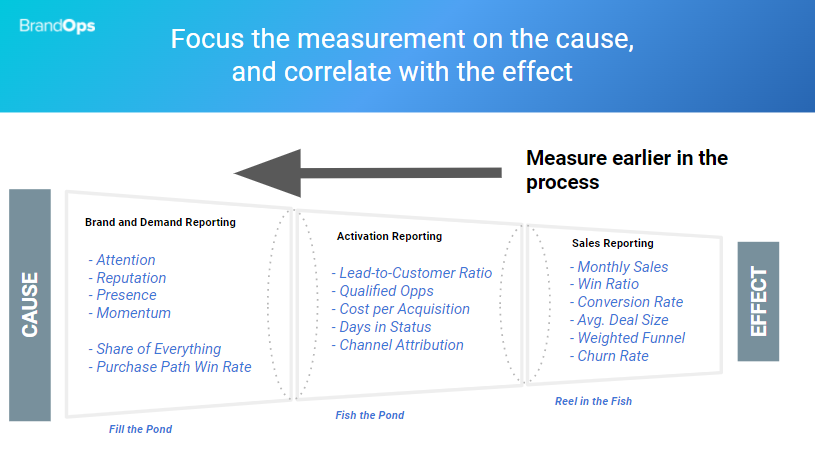Ending the brand vs performance marketing debate
5 minute read
We are human beings first, marketers second. It's why we gravitate towards self-preservation. The "brand vs performance" debate is the most relevant example of that. Turning the two into a zero-sum game may benefit an individual marketer's interests, but it will rarely benefit the company they work for. No matter what their job title says, all marketers are hired for the same reason: to create shareholder value. If they succeed in this, how they did it is less important because both brand and performance marketing are just different means to an end. This is what makes brand vs performance marketing a false dichotomy.
What marketers see
"It is difficult to get a man to understand something when his salary depends on his
not understanding of it."
If you're in the shoes of either of the two marketers, creating conflict makes sense. If the budget is limited, you'd rather have the budget assigned to you, not the other person. If only one of you will get hired, you'll push an agenda for why your work is impactful, and the other one is useless.
Oftentimes, this all comes down to politics.
Performance marketers: They run short-term marketing campaigns that can produce fast outcomes. They capture existing market demand instead of creating demand. For the non-marketers in corporate boardrooms, the growing pressure to achieve business outcomes fast has played a big role in performance marketers' popularity in the last decade. Because they're so closely tied to direct revenue, they think brand marketing is incapable of creating revenue because, unlike performance, brand marketers can't demonstrate the revenue impact directly. The very naming of "performance" marketing implies other types of marketing don't perform.
Brand marketers: They are concerned with creating long-term growth for the company. Unlike performance marketers, they don't have metrics that are directly attributable to revenue, because the nature of their work is indirect. The brand they build is a commercial asset that pays off in many ways: reduced CAC, customers' willingness to pay a premium, and more. Some brand marketers think performance marketing is cheap, wasteful, and comparable to spinning on a hamster wheel that will eventually break.
.jpg?width=1191&name=Image%20from%20iOS%20(4).jpg)
Brand and performance advertising exists on a spectrum: Stephen King's model
What the customers see
If we want to be customer-centric, we will acknowledge how the real purchase path looks like, and it's not pretty (Google coined this as "The Messy Middle"). This requires adapting to how people prefer to buy, not how marketers prefer to sell. This chaotic depiction of the purchase path makes sense: human beings are emotional, spontaneous, and flawed. They're certainly not as robotic as linear models suggest (e.g. generic marketing funnels).

Customers don't think in terms of marketing funnels or purchase paths. Nobody wakes up one morning and thinks: "I can't wait to enter the funnel for a SaaS brand tracking platform today!".
They don't distinguish between performance and brand marketing either. All customers see is a brand through a fusion of all touchpoints, both performance and brand marketing ones. As customers engage your brand across various channels, performance marketing will influence customer perception and brand marketing will drive performance. This alignment between brand and performance creates a growth loop. With it, brands are able to exceed customers' needs across all touchpoints, resulting in more revenue.
We used our own software to validate this. After analyzing over 300 companies across categories, we saw a pattern: brands that are dominating the purchase path are the category leaders. The messy purchase path can be reduced to a stats problem. The more presence a brand has on major purchase path channels, the more of the overall purchase path they own, which results in more revenue. More podcast mentions. More social mentions. More organic search presence. More everything. It aligns with The Ehrenberg Bass Institute's evidence on why physical availability is so important for brand growth.
This blog post will focus on measuring brand marketing's impact on performance.
If you're interested in the mechanics of how brand marketing amplifies performance marketing and vice versa, read this brilliant blog post by Michael Lorenzos.
The problem with measuring brand marketing
in the short term
If we acknowledge that the divide between performance and brand marketing doesn't exist in the customers' eyes, then we also accept that brand marketing can and should deliver on performance in the short term. It doesn't always happen, and this is when the critique towards brand marketers is justified. Some brand marketers will use the long-term nature of brand marketing as an excuse for not creating any short-term value. There's a prevailing belief that the ROI of brand marketing shouldn't be measured - a fair point if we're talking about "ROI" as a metric, but an unfair point if we use "ROI" as a catch-all term for "accountability to revenue" (which is more often the case). There are many other methods and metrics we can use to hold brand marketing accountable to revenue other than ROI. If brand and performance marketers want to get on the same page, they will need a unified measurement model that can tie brand marketing to revenue, instead of using "brand fame" or "reach".
Some marketers recommend using measurement proxies to connect brand marketing with performance in the short term, such as an increase in high-intent organic website visits, reduced CAC, or an increase in SQLs. While they can be good indicators and are quite practical, they aren't accurate enough.
Getting internal buy-in based on proxies doesn't make it any easier. Other marketers recommend estimating how strong your brand is by forecasting your baseline sales, using econometric analyses, or doing customer interviews. While they are very accurate measures, they are time-consuming and thus impractical for brand marketers concerned with short-term impact.
How we measure brand marketing in the short term
We recognized that holding brand marketing accountable to direct A->B effects and tracking them as marketing attribution does is misleading because brand effects are indirect. This called for a different correlation analysis altogether. Our model correlates ongoing brand marketing campaigns to performance from the top of the funnel, using AI to show a correlation between upstream input (brand marketing) on the performance effects further down the funnel. Because performance and brand goals are never the same for everyone, BrandOps correlates brand marketing to performance metrics of your choice, which incentivizes joint contribution over silos. For brand marketing planning, our AI runs "what-if" forecasting to project the impact of any brand marketing activity upstream with outcomes that are likely to happen downstream. This allows brand marketers to set brand marketing up for success very early and prove brand marketing's short-term contribution to performance.

How we measure brand marketing in the long term
All the brand scores in BrandOps are designed with business outcomes in mind. Brand leaders with more freedom for long-term brand building can use our brand scores to see where their brand is weak, what will lead to category leadership, and which signals (e.g. social mentions, LinkedIn follower count, etc.) contribute to each brand score. This lets them know what should be optimized for the most fruitful long-term outcomes (such as market share growth). Additionally, they can use BrandOps to measure their current brand health in order to understand what the strongest brand health drivers were up to this point.
-2.png?width=814&name=2021-11-23%20(1)-2.png)
The conclusion
A recurring theme in this blog post was about things interacting in a loop, rather than interacting as siloed entities. De-siloing brand and performance marketing and measuring their collective contribution to business outcomes isn't just a capability problem, it's also a cultural problem in what resembles that same loop where one problem creates the other.
Solving the cultural problem will come from the CMO aligning incentives within the marketing organization. The divide will continue to exist so as long there are individuals who benefit from it. Solving the measurement capability problem will come from a measurement model that portrays the brand in a holistic way with metrics that incentivize collaboration. With these loops in mind, we designed BrandOps to be a brand tracking platform that can create a de-siloed culture as much as it contributes to accurate brand marketing measurement. In a time of instant gratification and increasing customer demands, it has never been more important to meet their needs across the purchase path. Wherever you start from in solving this problem, you will be ahead of the curve.
Thank you for reading. We hope you enjoyed this blog post. It's inspired by Michael Lorenzos, who wrote a similar article on this topic. His piece was so good, we wrote this one as a "remix" to his, with more focus on brand marketing measurement.
You can find his article here.
If you want to learn about a better way to unite brand and performance marketing measurement
schedule a BrandOps demo with our team.
BrandOps is a unified brand tracking and measurement platform that provides marketing leaders with a continuous view of marketing performance and pinpoints areas that need improvement.



